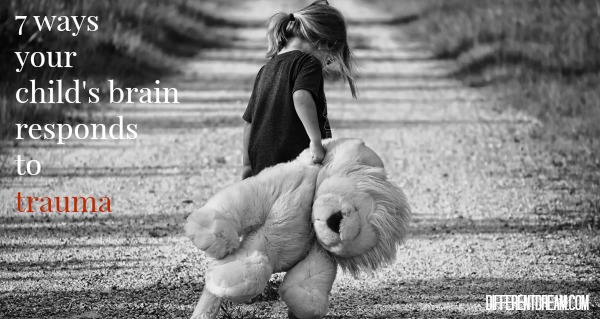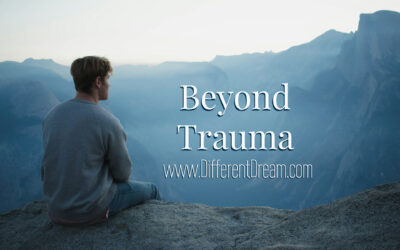Inside Out Special Needs Parenting: 7 Stages of Trauma Response

Today’s post is the fifth installment in a series about special needs parenting from the inside out. The series is the result of what I learned while researching Does My Child Have PTSD? What To Do When Your Child Is Hurting from the Inside Out.
The Seven Stages of Trauma Response
Our brains go through seven stages of trauma response when we can’t escape a perceive danger. These seven stages are explained in the Intensive Trauma Response (ITR) model developed by Dr. Louis Tinnin and Linda Gantt, the founders of Intensive Trauma Therapy (ITT), an outpatient trauma clinic located in Morgantown, West Virginia.
These stages are automatic and instinctual for newborns, infants, toddlers, children, adolescents, and adults who go through trauma. This post focuses how each trauma response is experienced in those under age 18. Parents familiar with these seven stages will better equipped to deal with their kids’ behavior during and after traumatic events.
Trauma Response #1: Startle
Startle is the quick, intense response which puts the body on high alert. Baby fingers splay, arms go rigid, and the babies cry. Toddlers, children, and teens tend to jump and gasp. Their hearts pound and their palms turn sweaty about things that adults shake off.
Trauma Response #2: Thwarted Intention
After the initial startle, the body releases a surge of hormones to prepare for fight or flight. When fight or flight aren’t possible, the thwarted intention response kicks in. As kids grow, they become strong enough to hide from perceived danger, to pitch magnificent fits, or to fight back. But babies can’t do any of those things. Therefore, the younger or more helpless children are in any given scary situation, the more like they are to reach the stage of thwarted intention.
Trauma Response #3: Freeze
When intentions are thwarted and there’s no hope of escape, the brain enters the freeze state. The body goes numb and immobile, at least for a moment or two. Children who experience similar, repeated traumas go through the two previous steps so quickly and automatically they may appear to have skipped them completely. They may freeze at the slightest hint of threat. No jump. No gasp. No attempt to fight or run. Their brains freeze and go offline for a while.
Trauma Response #4: Altered State of Consciousness
If the freeze state lasts for more than a few moments, the brain enters an altered state of consciousness. Adults often describe this state as watching a movie of themselves or the feeling of shrinking deep inside their bodies. When threatened, babies disengage and shut out the threat often through gaze aversion. Older children enter this stage by telling themselves, “This can’t be happening. It must be a dream.” Many children escape the situation through daydreaming.
Trauma Response #5: Bodily Sensations
These bodily sensations can be experienced during different stages in the ITR model. All of them are stored as non-verbal memories in the right brain. They remain there as sensations that can’t be put it into words. This step is especially risky from birth to age three because young children have no words. The memories are like terrifying movies playing over and over inside the brain. As children get older, their rational mind can’t explain these sensations, so many adolescents think they’re going crazy.
Trauma Response #6: Automatic Obedience
This instinctual response causes a person to automatically obey a perpetrator’s demands in order to survive the immediate threat. For children in life and death situations, automatic obedience is an appropriate survival response. Therefore, babies undergoing hospital procedures learn to lie quietly when people hurt them. Toddlers surrender when grown-ups touch their private parts. Young children do whatever their parents say to avoid a beating or verbal abuse. Automatic obedience is often the only survival weapon children have until their old enough or big enough to fight back.
Trauma Response #7: Self-Repair
After the threat passes, children tend to the emotional and physical wounds of trauma. Children instinctually seek out a favorite blankie, a stuffed animal or people they trust to comfort them. Sleeping, eating, rocking, going to a quiet place, and washing are other forms of self-repair. Young children revert to sucking their thumbs again or using a bottle instead of a sippy cup. Older children regress to baby talk or demand a nightlight at bedtime. These behaviors are attempts to return to a safer, more comfortable time before the trauma happened.
Hope for Traumatized Kids
Keep a few things in mind while reflecting on these seven stages. First, all children face perceived threats and go through these stages. But research shows that children who have a compassionate, calm parent or caregiver to help them process the event are much less likely to experience long term mental health issues. Second, children dealing with unresolved trauma or PTSD that develops from it can be successfully treated by trained trauma treatment professionals.
The next post in this series will look at symptoms of PTSD in children from birth to age 3, ages 4 to 6, 7 to 12, and 13-18. Until then, you can learn more about the seven stages described above in The Instinctual Response and Dual-Brain Dynamics: A Guide for Trauma Therapy by Dr. Louis Tinnin and Linda Gantt, and in Does My Child Have PTSD? What To Do When Your Child Is Hurting from the Inside Out by Jolene Philo.
Your Thoughts?
Do you have insights or questions about the seven stages of the ITR model? Feel free to share them in the comment box.
Inside Out Special Needs Parenting, Part 1
Inside Out Special Needs Parenting, Part 2
Inside Out Special Needs Parenting, Part 3
Inside Out Special Needs Parenting, Part 4
Do you like what you see at DifferentDream.com? You can receive more great content by subscribing to the quarterly Different Dream newsletter and signing up for the daily RSS feed delivered to your email inbox. You can sign up for the first in the pop up box and the second at the bottom of this page.
By Jolene
Jolene Philo is the author of the Different Dream series for parents of kids with special needs. She speaks at parenting and special needs conferences around the country. She’s also the creator and host of the Different Dream website. Sharing Love Abundantly With Special Needs Families: The 5 Love Languages® for Parents Raising Children with Disabilities, which she co-authored with Dr. Gary Chapman, was released in August of 2019 and is available at local bookstores, their bookstore website, and at Amazon.
4 Comments
Submit a Comment
Subscribe for Updates from Jolene
Related Posts
How Do I Let Go of My Adult EA/TEF Child?
Valeria Conshafter explores the question “How do I let go of my adult EA/TEF child?” for EA/TEF Awareness Month.
The Physical Manifestations of Grief in Caregivers
Jolene explains how the heaviness of loss and sorrow can contribute to the physical manifestations of grief in caregivers.
Experiencing Post-Traumatic Growth while Raising a Child with Disabilities
Jolene explains the benefits of experiencing post-traumatic growth while raising a child with disabilities.






Wendy, if your son is not yet seeing a therapist about his trauma issues, you would be wise to find one. A good therapist may have ideas concerning the SPD issues, too. Jolene
I see the last three particularly with my son, he is medically complex and has had many invasive procedures. He is also mild SPD. I am now worried I am not responding correctly to his sensory issues.
You’re welcome!
Great, useful information. Thanks for sharing.